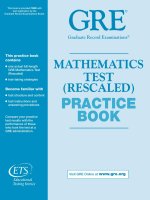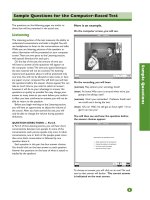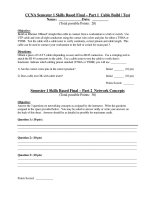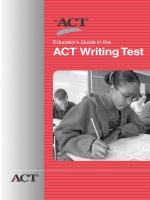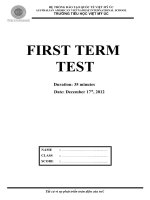Education skill test pptx
Bạn đang xem bản rút gọn của tài liệu. Xem và tải ngay bản đầy đủ của tài liệu tại đây (81.82 KB, 6 trang )
Time Preparation
Exam minus 6 months Take the CBEST Diagnostic in Chapter 3 and skim the 24 lessons in the Mini-
Course. Based on your scores on the individual sections of the diagnostic exam,
divide up the next 5 months into segments of time which you estimate each lesson
will take. Be sure to schedule in more time on those skills that give you problems.
Exam minus 6 months Work steadily and calmly through each lesson, sticking to your schedule and being
to 2 months sure to do the practice exercises. Besides doing the lessons, be sure to read more
during these months than you are accustomed to—novels, non-fiction books, mag-
azines, newspapers; it is very important for the CBEST that your reading skills be
honed. Also, look at the “More Help” section of the Mini-Course. Choose one or
two books from the area that gives you the most trouble, and use them to help you
improve your weak area.
Exam minus 2 months Take the first practice exam, CBEST Practice Exam 1. Use your score to help you
decide where to concentrate your efforts. Review the relevant lessons of the Mini-
Course and get the help of a friend or teacher. If necessary, choose additional
resources from the “More Help” section of the Mini-Course to help you.
Exam minus 2 weeks Take the second practice test, CBEST Practice Exam 2, to see how much you’ve
improved, and then, again, review the areas that give you the most trouble.
Exam minus 1 day Relax. Do something unrelated to the exam. Eat a good meal and go to bed at your
usual time.
Schedule A: The Leisure Plan
Time Preparation
Exam minus 4 months Take the CBEST diagnostic in Chapter 3 and skim the 24 lessons in the Mini-
Course. Based on your scores on the individual sections of the diagnostic exam,
divide up the next 4 months into segments of time which you estimate each lesson
will take. Be sure to schedule in more time on those skills that give you problems.
Exam minus 4 months Work steadily and calmly through each lesson, sticking to your schedule and being
to 1 month sure to do the practice exercises. Besides doing the lessons, schedule in more
reading during these months than you’re used to doing—novels, non-fiction books,
magazines, newspapers; it is very important for the CBEST that your reading skills
be in top shape. If you fall behind in your schedule, remember that you’re in con-
trol—it’s your schedule. Don’t shrug your shoulders and moan, “I’ll never make it!”
Just take a look at the schedule, see where you went off track, revise the schedule
for the time you have left, and continue.
Exam minus 2 months Take the first practice exam, CBEST Practice Exam 1. Use your score to help you
decide where to concentrate your efforts. Review the relevant lessons of the Mini-
Course and get the help of a friend or teacher. If you need more help, choose addi-
tional resources.
Exam minus 2 weeks Take the second practice test, CBEST Practice Exam 2, to see how much you’ve
improved, and then, again, review the areas that give you the most trouble.
Exam minus 1 day Relax. Do something unrelated to the exam. Eat a good meal and go to bed at your
usual time.
Schedule B: The Just-Enough-Time Plan
13
Time Preparation
Exam minus 2 months Take the CBEST diagnostic in Chapter 3 and skim the 24 lessons in the Mini-
Course. Based on your scores on the individual sections of the diagnostic exam,
divide up the next month into segments of time which you estimate each lesson will
take. Be sure to schedule in more time on those skills that give you problems.
Exam minus 2 months Work quickly, but steadily and calmly, through each lesson, sticking to your sched-
to 1 month ule and being sure to do the practice exercises. Besides doing the lessons, sched-
ule in more reading than you usually do—novels, non-fiction books, magazines,
newspapers; it is crucial for the CBEST that your reading skills be their sharpest. If
you fall behind in your schedule, remember that you are the one who devised the
schedule, and you’re in control. Don’t take to your bed lamenting, “I can’t, I can’t!”
Just peruse your schedule, see where you went astray, revise the schedule for the
time you have left, and forge ahead.
Exam minus 2 weeks Take the first practice exam, CBEST Practice Exam 1. Use your score to help you
decide where to concentrate your efforts. Review the relevant lessons of the Mini-
Course and get the help of a friend or teacher. If necessary, get more help.
Exam minus 1 week Take the second practice test, CBEST Practice Exam 2, to see how much you’ve
improved, and then, again, review the areas that give you the most trouble.
Exam minus 1 day Relax. Do something unrelated to the exam. Eat a good meal and go to bed at your
usual time.
Schedule C: More Study in Less Time
Time Preparation
Exam minus 3 weeks Take the CBEST diagnostic in Chapter 3 and skim the 24 lessons in the Mini-
Course. Based on your score, choose one area to concentrate on this week: read-
ing, writing, or math. Spend an hour a day working on that area.
Exam minus 2 weeks First, skim over the CBEST Mini-Course lessons on the areas you didn’t study last
week. Choose 6 lessons to do in the first three days of this week. For the rest of the
days, go back to the one area you need the most work on, and review the lessons
that were most difficult for you.
Exam minus 1 week Take the first practice exam, CBEST Practice Exam 1. Use your score to help you
decide where to concentrate your efforts. Review the relevant lessons and get the
help of a friend or teacher on those areas.
Exam minus 3 days Take the second practice test, CBEST Practice Exam 2, to see how much you’ve
improved, and then, again, review the areas that give you the most trouble.
Exam minus 1 day Relax. Do something unrelated to the exam. Eat a good meal and go to bed at your
usual time.
Schedule D: The Cram Plan
14
Schedule C: More Study in
Less Time
If you have one to three months before the exam, you
still have enough time for some concentrated study
that will help you improve your score. This schedule is
built around a two-month time frame. If you have only
one month, spend an extra couple of hours a week to
get all these steps in. If you have three months, take
some of the steps from Schedule B and fit them in.
Schedule D: The Cram Plan
If you have three weeks or less before the exam, you
really have your work cut out for you. Carve a half-
hour out of your day, every day, for study. This sched-
ule assumes you have the whole three weeks to
prepare; if you have less time, you’ll have to compress
the schedule accordingly.
Step 4: Learn to Manage Your
Time
Time to complete: 10 minutes to read, many hours of
practice!
Activities: Practice these strategies as you take the
sample tests in this book
Steps 4, 5, and 6 of the LearningExpress Test Prepara-
tion System put you in charge of your exam by show-
ing you test-taking strategies that work. Practice these
strategies as you take the sample tests in this book, and
then you’ll be ready to use them on test day.
First, you’ll take control of your time on the
exam. The CBEST has a time limit of four hours,
which may give you more than enough time to com-
plete all the questions—or may not. It’s a terrible feel-
ing to hear the examiner say,“Five minutes left,” when
you’re only three-quarters of the way through the test.
Here are some tips to keep that from happening
to you.
■
Follow directions. If the directions are given
orally, listen to them. If they’re written on the
exam booklet, read them carefully. Ask questions
before the exam begins if there’s anything you
don’t understand. In your exam booklet, write
down the beginning time and the ending time of
the exam.
■
Pace yourself. Glance at your watch every ten or
fifteen minutes, and compare the time to how far
you’ve gotten in the exam. When one-quarter of
the time has elapsed, you should be a quarter of
the way through the exam, and so on. If you’re
falling behind, pick up the pace a bit.
■
Keep moving. Don’t waste time on one question.
If you don’t know the answer, skip the question
and move on. Circle the number of the question
in your test booklet in case you have time to
come back to it later.
■
Keep track of your place on the answer sheet.If
you skip a question, make sure you skip the cor-
responding bubble on the answer sheet too.
Check yourself every 5–10 questions to make sure
the question number and the answer sheet num-
ber are still the same.
■
Don’t rush. Though you should keep moving,
rushing won’t help. Try to keep calm. Work
methodically and quickly.
Step 5: Learn to Use the
Process of Elimination
Time to complete: 20 minutes
Activity: Complete worksheet on Using the Process of
Elimination
After time management, your next most important
tool for taking control of your exam is using the
–LEARNINGEXPRESS TEST PREPARATION SYSTEM–
15
process of elimination wisely. It’s standard test-taking
wisdom that you should always read all the answer
choices before choosing your answer. This helps you
find the right answer by eliminating wrong answer
choices. And, sure enough, that standard wisdom
applies to your exam, too.
Let’s say you’re facing a reading comprehension
question that goes like this:
13. According to the passage above, “Biology uses a
b
ino
mial system of classification.” In the context
of the passage, the word b
inomial most nearly
means
a. understanding the law.
b. having two names.
c. scientifically sound.
d. having a double meaning.
If you happen to know what binomial means, of
course, you don’t need to use the process of elimina-
tion, but let’s assume that you don’t. So you look at the
answer choices. “Understanding the law” doesn’t
sound likely for something having to do with biology.
So you eliminate choice a—and now you only have
three answer choices to deal with. Mark an X next to
choice a so you never have to read it again.
On to the other answer choices. If you know that
the prefix bi- means two, as in bicycle, you’ll flag answer
b as a possible answer. Mark a check mark beside it,
meaning “good answer, I might use this one.”
Choice c,“scientifically sound,” is a possibility.At
least it’s about science, not law. It could work here,
though, when you think about it, having a “scientifi-
cally sound” classification system in a scientific field is
kind of redundant.You remember the bi thing in bino-
mial, and probably continue to like answer b better.
But you’re not sure, so you put a question mark next to
c, meaning “well, maybe.”
Now, choice d,“having a double meaning.”You’re
still keeping in mind that bi- means two, so this one
looks possible at first. But then you look again at the
sentence the word belongs in, and you think, “Why
would biology want a system of classification that has
two meanings? That wouldn’t work very well!” If
you’re really taken with the idea that bi means two,you
might put a question mark here. But if you’re feeling a
little more confident, you’ll put an X. You’ve already
got a better answer picked out.
Now your question looks like this:
13. According to the passage above, “Biology uses a
binomial system of classification.” In the context
of the passage, the word binomial most nearly
means
Xa. understanding the law.
✓ b. having two names.
? c. scientifically sound.
? d. having a double meaning.
You’ve got just one check mark, for a good answer. If
you’re pressed for time, you should simply mark
answer b on your answer sheet. If you’ve got the time
to be extra careful, you could compare your check-
mark answer to your question-mark answers to make
sure that it’s better. (It is: the binomial system in biol-
ogy is the one that gives a two-part genus and species
name like homo sapiens.)
It’s good to have a system for marking good, bad,
and maybe answers. We’re recommending this one:
X = bad
✓ = good
? = maybe
If you don’t like these marks, devise your own system.
Just make sure you do it long before test day—while
you’re working through the practice exams in this
book—so you won’t have to worry about it during
the test.
–LEARNINGEXPRESS TEST PREPARATION SYSTEM–
16
Using the Process of Elimination
Use the process of elimination to answer the following questions.
1. d. You should have eliminated answer a imme-
diately. Ilsa can’t be four years old if Meghan
is going to be Ilsa’s age in five years. The
best way to eliminate other answer choices is
to try plugging them in to the information
given in the problem. For instance, for
answer b, if Ilsa is 10, then Meghan must be
5. The difference in their ages is 5. The differ-
ence between Ed’s age, 29, and Meghan’s
age, 5, is 24. Is 24 two times 5? No. Then
answer b is wrong. You could eliminate
answer c in the same way and be left with
answer d.
2. c. Note the word not in the question, and go
through the answers one by one. Is the truck
driver in choice a “operating a commercial
vehicle?” Yes, idling counts as “operating,”
so he needs to have a commercial driver’s
license. Likewise, the bus operator in answer
b is operating a commercial vehicle; the
question doesn’t say the operator has to be
on the street. The limo driver in choice d is
operating a commercial vehicle, even if it
doesn’t have a passenger in it. However, the
cabbie in answer c is not operating a com-
mercial vehicle, but his own private car.
Answers
Here are the answers, as well as some suggestions as to how you might have used the process of elimination to find them.
17
1. Ilsa is as old as Meghan will be in five years.
The difference between Ed’s age and Meghan’s
age is twice the difference between Ilsa’s age
and Meghan’s age. Ed is 29. How old is Ilsa?
a. 4
b. 10
c. 19
d. 24
2. “All drivers of commercial vehicles must carry a
valid commercial driver’s license whenever
operating a commercial vehicle.”
According to this sentence, which of the
following people need NOT carry a commercial
driver’s license?
a. a truck driver idling his engine while waiting
to be directed to a loading dock
b. a bus operator backing her bus out of the
way of another bus in the bus lot
c. a taxi driver driving his personal car to the
grocery store
d. a limousine driver taking the limousine to her
home after dropping off her last passenger of
the evening
3. Smoking tobacco has been linked to
a. increased risk of stroke and heart attack.
b. all forms of respiratory disease.
c. increasing mortality rates over the past ten
years.
d. juvenile delinquency.
4. Which of the following words is spelled cor-
rectly?
a. incorrigible
b. outragous
c. domestickated
d. understandible
3. a. You could eliminate answer b simply because
of the presence of the word all. Such
absolutes hardly ever appear in correct
answer choices. Choice c looks attractive
until you think a little about what you know—
aren’t fewer people smoking these days,
rather than more? So how could smoking be
responsible for a higher mortality rate? (If you
didn’t know that mortality rate means the rate
at which people die, you might keep this
choice as a possibility, but you would still be
able to eliminate two answers and have only
two to choose from.) And choice d is plain
silly, so you could eliminate that one, too. You
are left with the correct choice, a.
4. a. How you used the process of elimination
here depends on which words you recog-
nized as being spelled incorrectly. If you
knew that the correct spellings were outra-
geous, domesticated, and understandable,
then you were home free.
18
Even when you think you’re absolutely clueless
about a question, you can often use the process-of-
elimination technique to get rid of one answer choice.
If so, you’re better prepared to make an educated guess,
as you’ll see in Step 6. More often, the process of elim-
ination allows you to get down to only two possibly
right answers. Then you’re in a stronger position to
guess. And sometimes, even though you don’t know
the right answer, you find it simply by getting rid of the
wrong ones, as you did in the example above.
Try using your powers of elimination on the
questions in the Using the Process of Elimination
worksheet on the next page. The answer explanations
there show one possible way you might use the process
to arrive at the right answer.
The process of elimination is your tool for the
next step, which is knowing when to guess.
Step 6: Know When to Guess
Time to complete: 20 minutes
Activity: Complete worksheet on Your Guessing
Ability
Armed with the Process of Elimination, you’re ready to
take control of one of the big questions in test-taking:
Should I guess? The first and main answer is “Yes.”
Unless an exam has a so-called “guessing penalty,” you
have nothing to lose and everything to gain from
guessing. The more complicated answer depends on
you—your personality and your “guessing intuition.”
The CBEST doesn’t have a guessing penalty. The
number of questions you answer correctly yields your
score, and there’s no penalty for wrong answers. So
simply go ahead and guess. But try not to guess wildly
unless you absolutely have to. Remember to read the
question carefully.You may know more about the sub-
ject than you think. Use the process of elimination as
outlined in Step 5.
“Yes,” you might say, “but the whole idea of
guessing makes me nervous. I’m not good at guessing.”
Maybe, maybe not. Maybe you’re not much of a risk-
taker, so you don’t like to guess. But remember, noth-
ing bad can happen to you if you’re wrong.
But maybe you really think you have lousy intu-
ition. It seems like, when you have to guess, you always
guess wrong! Test out your assumption about your
guessing ability. Complete the Your Guessing Ability
worksheet to get an idea of how good or bad your intu-
ition really is.
Remember, nothing can happen to you if you’re
wrong.
Using the Process of Elimination
(continued)



